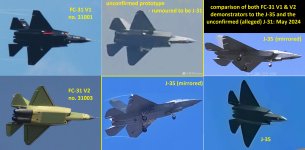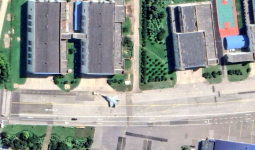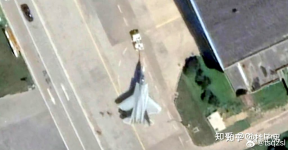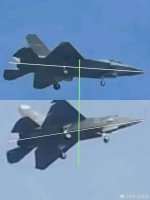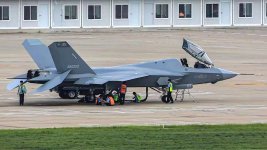MYSTERY REMAINS OVER LONG-AWAITED FIGHTERS
- Aviation Features
- MYSTERY REMAINS OVER LONG-AWAITED FIGHTERS
By
Andreas Rupprecht 2nd February 2017
FEATURE
AIR WARFARE BRIEFINGS FROM THE ASIA-PACIFIC
LATE DECEMBER SAW two important events in the continued development of China’s fighter saga, with the first flight of the second Aviation Industry Corporation of China (AVIC) FC-31 prototype closely followed by delivery of an initial batch of Sukhoi Su-35 fighters from Russia.
However, question marks remain over both the FC-31 program and Beijing’s acquisition of advanced ‘Flankers’.
It is uncertain what roles the Su-35 will play in the People’s Liberation Army Air Force (PLAAF) inventory, while it remains unclear whether China will even procure the fifth-generation FC-31.
At around 10.00hrs on December 23, 2016, the second — considerably revised — FC-31 prototype, sometimes known as the FC-31V2, successfully performed its maiden flight at the Shenyang Aircraft Corporation (SAC) airfield.
For around two years, observers had been waiting for the second FC-31 to fly. Some had already suggested it might be a ‘dead’ project. The second prototype was finally unveiled in a promotional video at Zhuhai on November 4, 2016. The first prototype, numbered ‘31001’ — and in fact closer to a technical demonstrator — was flown some four years ago. Since then the program has revealed little.
Long labeled as a ‘lower-end’ complement to the heavy and expensive Chengdu Aircraft Industry Corporation (CAC) J-20, it has been suggested that the FC-31 might enter service with the PLAAF as the J-31, or perhaps become the next carrier fighter to supplement and later replace the SAC J-15 on board the aircraft carrier Liaoning.
A flurry of rumors in 2016 suggested that the PLA had lost interest in the type. Nevertheless, reports persisted that a second airframe would appear soon, incorporating the major improvements embodied in model form during Airshow China at Zhuhai in 2014 in order to make it more attractive to customers.
It apparently features a single-piece canopy, a refined and slightly longer and wider fuselage, reshaped vertical tail fins, and cropped wingtips and tail fin tips. It is powered by WS-13A or E turbofan engines with ‘stealthy’ nozzles, features an electro-optical targeting system (EOTS) under the nose, and has a retractable refueling probe.
A maiden flight of the second FC-31 had been expected in late October 2016, perhaps to mark the anniversary of the first prototype’s inaugural flight on October 31, 2012. In the event, we had to wait until December 23. All images via Chinese internet
A static test airframe was reportedly built at SAC, and on July 3, 2016 a truck was spotted in China carrying a strange load comprising a covered ‘shape’ closely resembling the FC-31 prototype that had been transported in a similar fashion in mid-June 2012. Speculation now arose that this might be the longawaited second prototype. However, somewhat surprisingly, the transport was headed back to Shenyang and might therefore have been carrying the original first static airframe. Why this move was arranged in secrecy and under tight security is unknown. Based on the latest reports, the initial flying prototype, ‘31001’, tested the improved WS-13E for the first time on July 1, 2016.
SAC is keen to attract interest in the FC-31, especially as it will likely be its only card to play in the fighter business after the Chinese ‘Flanker’ series ceases production. These are critical times since it seems there will be no J-31 — at least for the time being. Based on the latest statements from AVIC, the FC-31 is only intended for export and has no support or funding from the PLAAF or Navy.
Consequently it remains to be seen whether any customers can be found, and this will of course also depend on the state of progress in flighttesting. Today, in contrast to the J-20, the FC‑31’s future remains in limbo, especially in the light of reports that a new single-engined fighter is under development at Chengdu.
Chinese Su-35s arrive
After seemingly endless rounds of negotiations, rumors, and finally a deal struck between China and Russian on November 19, 2015, the first Chinese Su-35 landed in China on December 25, 2016.
As if the questions surrounding the deal itself were not enough, the PLAAF then played a ‘cat and mouse’ game with the spotters. At first the four fighters landed as expected at the main Flight Test and Training Center (FTTC) base at Cangzhou/Cangxian. However, after a brief stop, they moved on to Suixi, home of the 2nd Fighter Division, 6th Air Regiment, perhaps hinting that they will replace the Su-27SK/UBK and J-11A fighters with that unit.
All in all, the deal for the delivery of 24 Su-35s is highly intriguing. It was never officially confirmed by the Chinese side, but has often been announced in the Russian media, including by the state technologies corporation Rostec. It is reportedly estimated to be worth $2 billion — or around $83 million per unit — and makes the PLAAF the first foreign customer for the aircraft.
Most previous estimations suggested that the fighters were intended not for an operational regiment, but more likely a dedicated FTTC regiment to explore the thrust-vectoring engines and for dissimilar air combat training (DACT) against other PLAAF assets, perhaps during the ‘Red Sword’ exercise. The surprise move to Suixi — and a division assigned to the allimportant Southern Theater Command — could be a hint that the PLAAF has other priorities, especially in this disputed area. One possibility is that the Su-35 will be used as a long-range fighter escort for Xi’an H-6K bombers around the South China Sea or even facing Japan.
Whatever the case, the PLAAF clearly does not want to make the deal public. While the PLAAF has become relatively ‘open’ in regards to its latest homegrown products, in this case everything remains a mystery.
Only two images of the PLAAF Su-35 have been leaked to date and both are very small and blurred. One was so similar to a shot of a Russian Air Force Su-35S that at first its true identity was questioned.
Originally published in Combat Aircraft Journal



